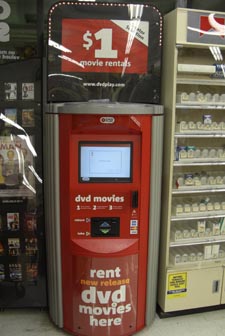 Low-price rental of DVDs through kiosks is growing rapidly. Redstar, the industry leader, has grown from 6,700 video kiosks U.S-wide about January 2008 to more than 20,000 expected by year-end 2009. In early May of this year, Video Business reported that DVDPlay had 1,200 kiosks and NCR had 2,200 MovieCube kiosks, with plans to add another 10,000 in a venture with Blockbuster. All of these companies’ kiosks offer movie rentals on DVDs for $1 a day.
Low-price rental of DVDs through kiosks is growing rapidly. Redstar, the industry leader, has grown from 6,700 video kiosks U.S-wide about January 2008 to more than 20,000 expected by year-end 2009. In early May of this year, Video Business reported that DVDPlay had 1,200 kiosks and NCR had 2,200 MovieCube kiosks, with plans to add another 10,000 in a venture with Blockbuster. All of these companies’ kiosks offer movie rentals on DVDs for $1 a day.
Low-cost media rental kiosks will press downward on prices for video distributed via communications network. If the history of the book rental business is any guide, the video rental business will fade away as persons get video cheaply and conveniently through alternative sources, and as genres, formats, and entertainment options multiply. The marginal cost of producing and distributing a video through a kiosk is much lower than the marginal cost of printing a book and distributing it through a book rental location (books have more atoms in more macroscopically different forms). Thus for video the price pressure is likely to be greater, and the incentive to differentiate, also greater. An interactive program of personalized short videos, which is what YouTube offers, can’t be delivered physically via DVD rentals. If the video market shifts away from blockbusters, the capacity constraints of kiosks will be more of a disadvantage. Video kiosks are a potent disruption in the traditional video distribution business. They will force communication networks to invest more in new video and entertainment forms that play to the advantages of online communication.
A fundamental aspect of the challenge of generating revenue from online content is that renting and buying don’t map well onto the online experience. What’s the difference between renting and buying online content?  Renting offline means you have the right to use some good for a fixed period of time. But online, which offers access to everything all the time, why would anyone ever pay for the right to use something ahead of the actual use time? Buying offline is typically understood as possession: you get a good that you buy. But what does buying a video that’s delivered online mean? It means acquiring some bundle of rights that are not at all familiar or intuitive. That’s a business problem.
Renting offline means you have the right to use some good for a fixed period of time. But online, which offers access to everything all the time, why would anyone ever pay for the right to use something ahead of the actual use time? Buying offline is typically understood as possession: you get a good that you buy. But what does buying a video that’s delivered online mean? It means acquiring some bundle of rights that are not at all familiar or intuitive. That’s a business problem.
The development of common understandings of new use rights would help to make online content more commercially feasible. New digital use rights might include rights such as rights to make conversions across output devices, to construct new content compilations (playlists), and to make derivative works (mashups, adding audio content to user-generated videos). Developing alternatives to totalitarian copyright is in content creators’ best interests.